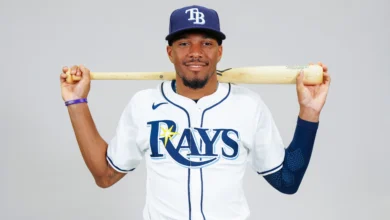
CLEARWATER, Fla. – Circled on the calendar as one of the most consequential days in the Tampa Bay Rays’ history, the drama and theatre did not disappoint.
At stake was approving $312 million in bonds to help fund a $1.3 billion stadium for the Rays and represent the cornerstone of a projected $6.5 billion development in St. Petersburg’s historic Gas Plant district. By a 5-2 vote on Dec. 17, the Pinellas County Board of Commissioners voted to honor their share of the stadium project.
In what appears as a never-ending saga, the funding seems in place, but that is only the beginning. Both the city of St. Petersburg and Pinellas County, site of the proposed stadium, fulfilled contractual obligations. Now, the project lays squarely with the Rays.
When the Pinellas County commissioners delayed a bond vote by essentially two months earlier this year, the Rays said they could not absorb cost overruns. If the county issued bonds as early as two months ago, the Rays believed they could put shovels in the ground early next month and open their new stadium for the start of the 2028 season. With a delay of two months, the Rays countered by indicating they could not undertake projected cost overruns.
Now, that seems a critical issue.
After the Pinellas commissioners voted early Tuesday night to approve bonds, the Rays issued a statement in which they reiterated the club cannot absorb cost overruns. At the same time, the Rays said they remain ready to resolve funding issues.
That did not sit well with Kathleen Peters, chair of the board of commissioners.
“At this point, we are holding the Rays to contractual obligations,” she told reporters after the vote. “We have fulfilled our contractual obligation, and we will continue to do our part. If the Rays want to renegotiate and ask for more money, I can tell you that I know there is not one commissioner on this board that would be entertaining renegotiating if the Rays ask for more money. They certainly can work with Major League Baseball and they certainly can work with their investors to come up with the funding.”
One surprise swing vote was casted by Chris Latvala, who previous announced he opposed the project. In open forum, Latvalia told his fellow commissioners, “the reason why I am voting for the bonds is (Major League Baseball Commissioner) Rob Manfred.”
In announcing support, Latvala augmented his position with a plea that Rays’ current owner Stuart Sternberg sell the team. “(Manfred) is the reason I am voting yes. MLB is aware of several instances where the Rays organization has intentionally tried to sabotage the very deal they agreed to honor,” Latvala said
The importance and magnitude of the vote was never in dispute. Either the bond funding is approved, and the Rays move ahead with plans to build a new stadium near the site of the present Tropicana Field, or pack your bags. Moving this franchise was a clear option and cities like Nashville and Portland remain hot on Major League Baseball’s expansion and relocation radar screen.
The future of this franchise on the west coast of central Florida was at stake and the enormity of the commissioners’ vote Dec 17 was prodigious. In the end, this was a desire of the commission and the community “to partner” together.
Those who oppose the stadium project cite a current and pressing need to improve the sewage system and infrastructure. Peters pointed out repeatedly that stadium funding could only be derived from hotel and tourist tax dollars. These funds, she pointed out, are considered restrictive funds, and mean these monies can be used for a sole purpose.
Once the county realizes a return from taxes and investments, Peters said, then that money could go to improving the infrastructure.
“We feel like we’ve been running a marathon, and I’ve run a few,” Commissioner Brian Scott told reporters afterward. “This is the toughest one I’ve ever done. I’m extremely pleased we finally had this done. This provides to our business community and the county that we honor commitments made back in July. I do think we will see a new stadium. There is no better opportunity for the Rays than what we have done (on Dec. 17).”
Now, the Rays must respond with definite architectural and site development plans. If the Rays comply and find the cost overrun funding (still to be determined), there could be shovels in the ground in a manner of a few months. If that’s the scenario, the Rays could move into their new stadium in time for the 2029 season.
With the contract in place, the Rays have until March 31, 2025 to meet their contractual obligations or the current agreement is terminated.
On the diamond … the reporting date for pitchers and catchers was announced earlier this month, and these players report to the Rays’ spring training site in Port Charlotte on Feb. 10th … during the current off-season, Erik Neander, the Rays’ director of baseball operations, explained the strength of the team will likely be a plethora of starting pitching. Left-hander Jeffrey Springs (23-12, 3.39 ERA in seven major league seasons) became the first casualty. That’s when Neander dealt Springs to Oakland for pitcher Joe Boyle and first baseman Will Simpson. When the Rays break camp in late March, Boyle could find a spot on roster. Williams, only two seasons from playing for the University of Washington, will likely open the 2025 season at AA or AAA. Williams, a power-hitter from the right side, should accrue skills at the minor league level. That will give the Rays time to figure out what to do with veteran first baseman Yandy Diaz, who was hobbled with leg injuries for most of last season.





